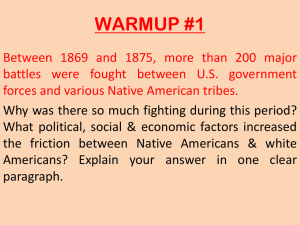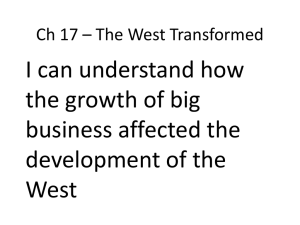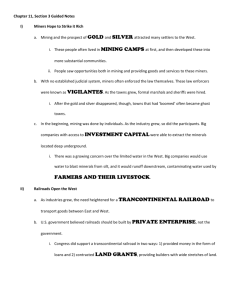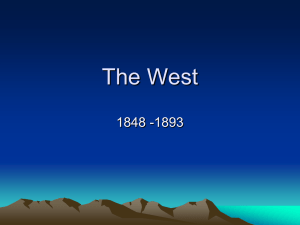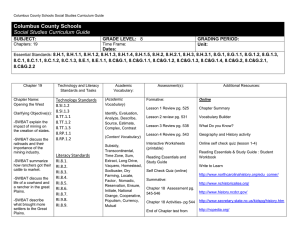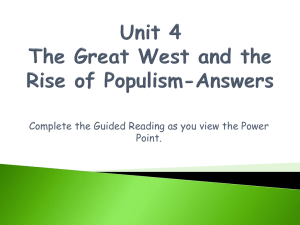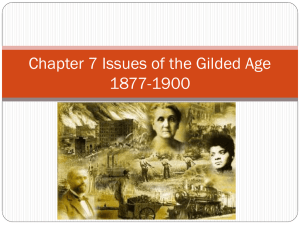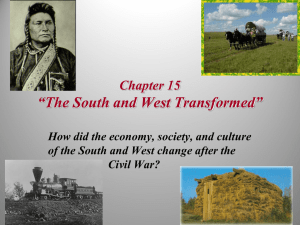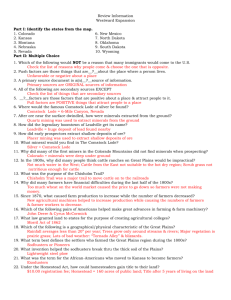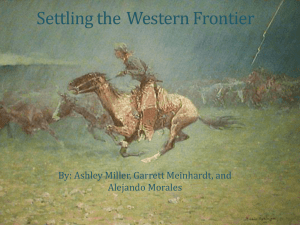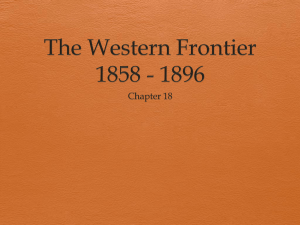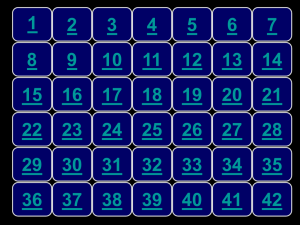Section 1
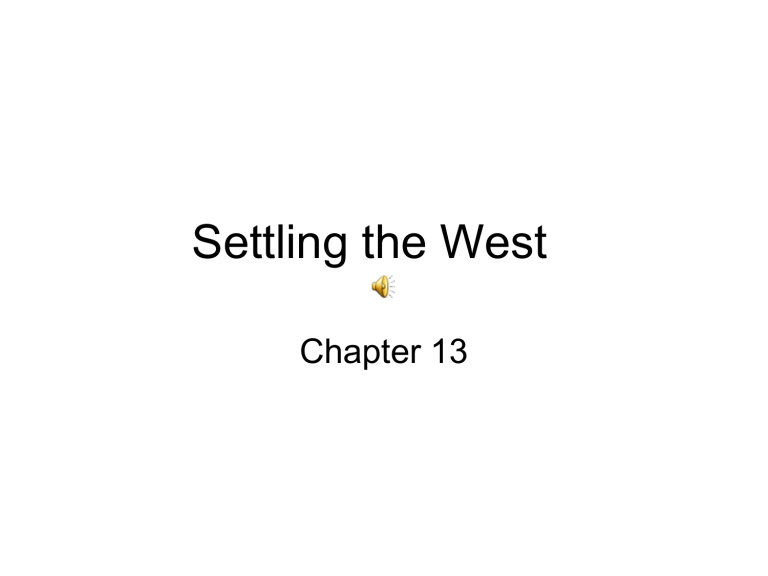
Settling the West
Chapter 13
Objectives
• Trace the growth of the mining industry in the
West
• Describe the ways that new technology changed open-range ranching
• Explain how and why people began settling the
Plains
• Trace the growth of commercial farming on the plains
• Discuss conflicts that arose between the Plains
Indians and American settlers
• Summarize the problems caused by attempts to assimilate Native Americans
Key Terms
• Hydraulic Mining
• Henry Comstock
• Open Range Cattle
• Chisholm Trail
• Barbed Wire
• Homestead Act
• “Great American
Desert”
• Dry farming
• Bonanza Farms
• Oklahoma Land Rush
• Morrill Act 1862 1890
• Nomads
• Indian Peace
Commission
• George A. Custer
• Ghost Dance
• Dawes Act
The Frontier
• Mining huge industry
• Ranchers cattle and sheep on public land
• Farmers fail--- bad weather, high cost of storing and transporting
• New inventions--- steel plow mechanical reapers and windmills make it possible —barbed wire
• Farmers make own party
• Railroads connect the west
• Plains Indians are destroyed
Mining Industry
• West is rich in gold, silver, and copper
• Brought settlers
• Placer Mining--shallow deposits used picks, shovels, and pans
Mining
►
►
►
►
►
►
►
►
►
Henry Comstock--- miner found Silver ore
Brought hoards of people to Nevada
Became a boom town
Silver gone
This cycle was repeated
Gold --- Colorado, Dakota Territory, Montana
Northern Greater Plains developed
Railroads built
Congress divides the territory –North and South
Dakota Montana
Impact of Mining
►
Small mining gives way to big business
►
Surface materials were quickly taken
►
Ended up in hands of eastern bankers
►
Miners were first to realize importance of west
►
Added to nations wealth
►
Paper backed by gold and silver
►
Mining improved the supply of money
First Transcontinental Railroad
Gold encouraged building for railroad
Connected East to West
Omaha, Nebraska and end in
Sacramento California
First Transcontinental Railroad
Union built Omaha to West
Central Pacific stared in Sacramento
Met at Promontory Point, Utah
Why are the Railroads
Important??????
Get people to the mines
Allowed western settlement
Made it possible to move cattle back east
Quick way to transport goods
Made ranching and farming profitable
Cattle Drives
Cattle Ranches--- too dry
Texas Longhorns
Ranches were able to grow
Open Range – grassland owned by government provided land ranchers could graze cattle ---free unrestricted
Long drives from Texas to sale
Chisholm Trail – route to Abilene major route town filled with cowboys and miners
Cattle Farming
Driving Cattle becomes popular
Sheep herders moved their flock
Cattle farmers blocked
“range wars” barbed wire makes appearance
Livestock is prevented from roaming
Long Range Drives are ended
Cattle now raised in fences, longhorns disappear, and cowboys become ranch hands
Farming on the Plains
“Great American Desert”
Construction of railroads and credit to prospective settlers
Pamphlets and Posters “ticket to prosperity”
Homestead Act--- 10 dollars (registration fee) claim up to 160 acres and after living there for 5 years receive title
More willingly to move
Farming on Plains
Dry Farming --- Plant deep where there was moisture
Steel plows, seed drills, and reapers
Wheat became the crop
More people moved
Wheat Belt – Dakotas, western parts of
Nebraska and Kansas
Farms covered up to 50,000 acres called
Bonanza farms – big farms
Wheat Farming
1880’s United States leading exporter
Prices drop
Farmers had to mortgage land
Homesteaders head home
What is a homesteader??????
Closing Frontier
1889 last of frontier closed--- Oklahoma
10,000 people raced to stake claims
Oklahoma Land Rush
Land Grant Universities
• Morrill Acts 1862
1890 –
• Granted land to colleges to teach
• Agriculture, Military
Tactics, Mechanic
Arts
• Alabama Polytechnic
Institute
Native Americans
Great Plains were inhabited
Nomads
Placed belief in power of natural world
Buffalo main food source
Settlers began moving
Buffalo decrease
Direct cause railroads –used for food and killed for blocking and destroying railroad tracks
Killed just for hides ---
Plains depended on them –food, shelter, tools. Weapons
Plains Indians
Government wanted Native Americans to farm
Killing of buffalo
Move to reservations —stop being nomads ---
Causes conflicts
Settlers number grew =conflicts
Conflicts
Sand Creek Massacre – Native
Americans distrust white men --why???
Colorado militia slaughtered innocent women and children ----
Do not get charged with a crime
Fetterman Massacre---
Battle of Little Big Horn
Big Change
Ranchers, miners, farmers
Forced relocation (not honor treaties)
Attack wagon trains and ranches
Sioux in Minnesota
Dakota Sioux agreed to live on reservation
Government issued annuities ---payments
Ended up with the traders
1862 Congress delayed payments
Starving to death
Big Change
Little Crow asks traders for food
Myrick ---
“let them eat grass…”
Found dead
Uprising
Hundreds are slaughtered
Tribunal many put to death
Several Indian uprising Fetterman’s Massacre and Sand
Creek Massacre
Indian Peace Commission--- 2 large reservations
Indian Peace Commission
2 large reservations
Indian Affairs (federal agency)
Last Wars
Many left reservations
Overrun with gold miners
Battle of Little bighorn
1876--- Custer leader
Underestimated fighting capabilities
Launches attack
Native Americans actually win
Custer is painted as victim of massacre
Army stepped up
Wounded Knee
Ghost Dance --- defied government order
Symbolic dance –settlers disappear, buffalo return, and return of deceased ancestors
Government tried to break it up
Battle ensued 25 soldiers and 200 Native
Americans died
Native Americans
A Century of Dishonor 1881--- described the abuse
Assimilation---- break up reservations
Families could be self supporting
Dawes Act --- 1887 allotted 160 to each head of household
Single –80 children 40
Land sold to settlers $ going to fund
Fails --- dependant on buffalo for food
Had to adapt to settlers way of life
Farmers
Grange --- fraternal order of farmers
Upset : High Tariffs, income did not keep up with rest of economy, hard time paying debts, bade weather, expensive machinery, high rates to ship,
Form own political party =Grange
To unite farm families
Coops and farmers alliance ---cheap seed and fertilizers
Farmers alliance = exchanges ---force prices up interest rates down
Farmers Demands
Ocala Demands ----
Free unlimited coining of silver coins (reduce inflation)
Tighter regulations on railroads
Suppport for the sub treasury plan (government warehouses
End protective tariffs
Graduated income tax
Direct election of Senators
Why?????
Greenbacks --- formed to fight inflation
More money in circulating less it is worth pay debt off
Railroads –monopoly on transportation
Warehouses ---store crops till price rose – called the sub treasury plan - government loan money to pay off crops –farmer could hold the crop in warehouse till price rises
Populist Party
People’s Party
Help farmers
Sherman Solver Purchase Act 1890– keep farmers voting Populist --- treasury purchase 4.5 million ounces silver per month
Put up a candidate for President
Essay
• Obviously, there was animosity between the
Native Americans and the people making the move out west. Describe the federal governments attempt to resolve the conflict
(including the consequences of it) and the attempt to assimilate Native Americans into
American society.
• Dawes Act, allotments, Indian Peace
Commission, Battle of Little Bighorn, and
Wounded Knee
Study Guide
• Comstock Lode
• Transcontinental Railroad ---where it started and ended and importance
• Sherman Silver Purchase Act
• Farmers Party –why formed and what it stood for
• Grievances of Farmers
• Ocala Demands
• Sub treasury plan
• Governmental control of Native Americans ---what did they want
• Importance of railroads
Study Guide
• Promontory Point, Utah
• What closed the frontier
• Impact of mining
• Disappearance of Buffalo --- what caused it
• Farmers alliance
• Cooperative
